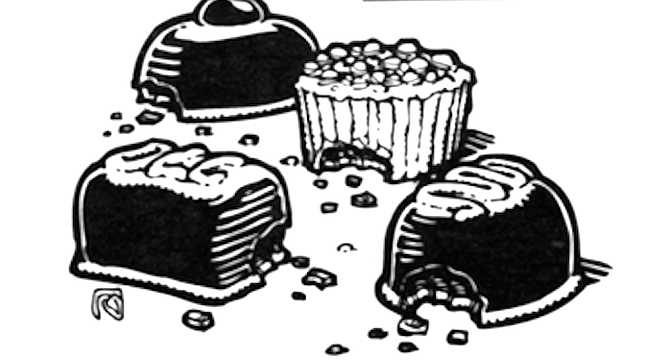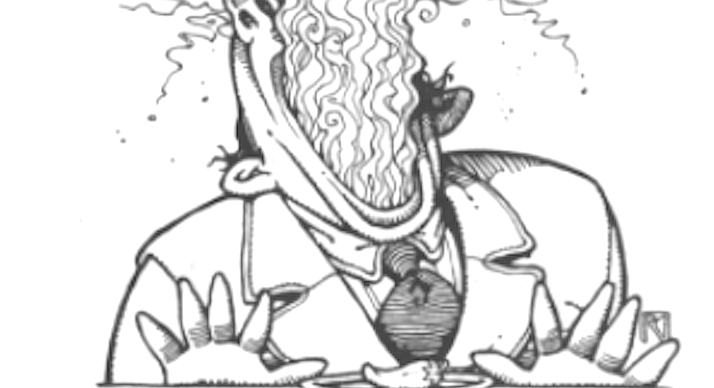 Facebook
Facebook
 X
X
 Instagram
Instagram
 TikTok
TikTok
 Youtube
Youtube

An unmarked lid allows Mrs. See and her customers to free-associate, sweets-wise, and put whatever they like into a box. If this idea seems frivolous or frightening, here’s another solution. Make a note of the shape of each piece of candy and the configuration of its decorative topknot of chocolate coating, then identify what’s inside. Next time you confront a piece with that same shape and decoration, consult your chart. Confectioners have flavor-coded the tops of their dipped chocolates for decades. Each maker has his own patterns, so you’ll have to analyze every brand.
By Matthew Alice, Nov. 9, 1995 Read full article
The chocolate centers are made in molds, then they trundle along a special conveyor where they’re covered with many, many thin but sturdy coats of candy shell. When the coating’s thick enough so they melt in your mouth, not in your hand, the candy’s dumped into a large drum, like a clothes dryer. They bump and slide around each other to polish off any drips or rough spots and acquire their shiny finish.
By Matthew Alice, Nov. 13, 1997 Read full article

We’ll have to go back, back, back in time for the answer to this one. It has to do with where the early butter-packaging machinery came from. The East Coast imported German machinery, which produced long, thin quarter-pounders. West Coast equipment was more often Danish. Shorter, fatter. It’s just some sort of weird tradition. If you live in St. Louis, I don’t know what you do.
By Matthew Alice, Feb. 20, 1997 Read full article

When the wet parts of the Krispie finally pull hard enough, the dry parts snap open and make a noise loud enough for you to hear. Have you ever picked up a stick and bent it by pulling on the ends? If you bend it far enough, the stick finally snaps. That’s pretty much what happens in your cereal bowl.You might notice that some other cereals make a little noise when you pour milk on them. But the Krispie people make sure they toast the rice in just the right way so the snaps and crackles and pops are good and loud.
By Matthew Alice, Aug. 5, 1993 Read full article

Equally mysterious is why humans would voluntarily, even eagerly, consume hot peppers. After all, the capsaicin is in there in the first place to protect peppers from being eaten by animals or invaded by insects. The plant assumes we’ll have more sense than to intentionally put in our mouths something we know will cause watery eyes, a runny nose, scorched mouth, sweating, and intestinal emergencies. There’s a theory making the rounds that the alkaloid actually releases pleasure-inducing endorphins in our brains.
By Matthew Alice, June 30, 1994 Read full article
The 57 is and always was a bogus number. At least to everyone but H.J. Heinz, the condiment baron who founded the company in the mid-1800s. He stole the idea from a shoe store ad that bragged of offering 20 different styles. Apparently he reasoned that if the slogan will sell shoes, it’ll sell horseradish. The company already made 60 or 70 varieties of packaged foods, but H.J. liked the sound of “57,” so “57.”
By Matthew Alice, Apr. 21, 1994 Read full article


An unmarked lid allows Mrs. See and her customers to free-associate, sweets-wise, and put whatever they like into a box. If this idea seems frivolous or frightening, here’s another solution. Make a note of the shape of each piece of candy and the configuration of its decorative topknot of chocolate coating, then identify what’s inside. Next time you confront a piece with that same shape and decoration, consult your chart. Confectioners have flavor-coded the tops of their dipped chocolates for decades. Each maker has his own patterns, so you’ll have to analyze every brand.
By Matthew Alice, Nov. 9, 1995 Read full article
The chocolate centers are made in molds, then they trundle along a special conveyor where they’re covered with many, many thin but sturdy coats of candy shell. When the coating’s thick enough so they melt in your mouth, not in your hand, the candy’s dumped into a large drum, like a clothes dryer. They bump and slide around each other to polish off any drips or rough spots and acquire their shiny finish.
By Matthew Alice, Nov. 13, 1997 Read full article

We’ll have to go back, back, back in time for the answer to this one. It has to do with where the early butter-packaging machinery came from. The East Coast imported German machinery, which produced long, thin quarter-pounders. West Coast equipment was more often Danish. Shorter, fatter. It’s just some sort of weird tradition. If you live in St. Louis, I don’t know what you do.
By Matthew Alice, Feb. 20, 1997 Read full article

When the wet parts of the Krispie finally pull hard enough, the dry parts snap open and make a noise loud enough for you to hear. Have you ever picked up a stick and bent it by pulling on the ends? If you bend it far enough, the stick finally snaps. That’s pretty much what happens in your cereal bowl.You might notice that some other cereals make a little noise when you pour milk on them. But the Krispie people make sure they toast the rice in just the right way so the snaps and crackles and pops are good and loud.
By Matthew Alice, Aug. 5, 1993 Read full article

Equally mysterious is why humans would voluntarily, even eagerly, consume hot peppers. After all, the capsaicin is in there in the first place to protect peppers from being eaten by animals or invaded by insects. The plant assumes we’ll have more sense than to intentionally put in our mouths something we know will cause watery eyes, a runny nose, scorched mouth, sweating, and intestinal emergencies. There’s a theory making the rounds that the alkaloid actually releases pleasure-inducing endorphins in our brains.
By Matthew Alice, June 30, 1994 Read full article
The 57 is and always was a bogus number. At least to everyone but H.J. Heinz, the condiment baron who founded the company in the mid-1800s. He stole the idea from a shoe store ad that bragged of offering 20 different styles. Apparently he reasoned that if the slogan will sell shoes, it’ll sell horseradish. The company already made 60 or 70 varieties of packaged foods, but H.J. liked the sound of “57,” so “57.”
By Matthew Alice, Apr. 21, 1994 Read full article
Comments